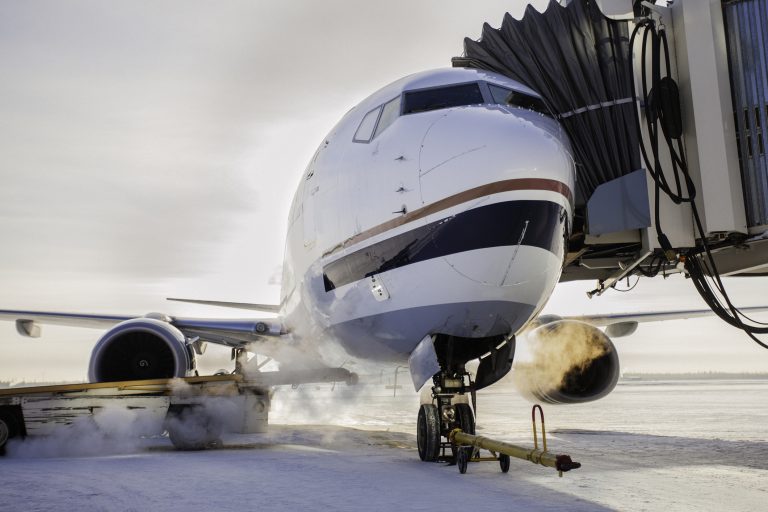
January 15, 2019

FLIGHT CONTROL
Delayed flights might be good for airport bars and newsstands, but they’re terrible for airlines and passengers. This perennial problem isn’t just a mere inconvenience, either: Commercial flight delays, due to things like weather, maintenance or crew issues, cost carriers and their customers more than $25 billion a year. But a new suite of digital solutions from GE Aviation could help airlines reduce delays and cancellations significantly, while improving on-time performance. It’s the brainchild of a team led by a man who’s been looking to the skies since childhood.
Plane genius: Growing up in San Francisco in the 1970s, Mike Arguello loved hanging out at the airport, waiting for relatives visiting from Central America. Even then, he noticed flights were often delayed. Completing his doctoral thesis at the University of Texas at Austin, Arguello worked on technology that could automate and recover crew schedules when flight disruptions scrambled the existing lineup. At GE Aviation, Arguello and his team have been able to develop algorithms that crunch the numbers and can help predict flight disruption patterns. “Anyone can figure out the impact of a closure of an airport to existing operations,” says Arguello. “The hard part is piecing things back together so you’re operating the rest of the schedule at maximum velocity.”
Piece together the rest of Arguello’s journey here.
TOUGH STUFF
Six decades ago, the development of the first silicon transistor changed electronics forever, allowing for the creation of much smaller and vastly more complicated electronics systems. Still, silicon’s got a major weakness: The material just can’t take the heat and begins to degrade above 125 degrees Celsius. Engineers’ longtime solution to this problem has been to design systems that keep the temp down by using fans and other cooling devices. But another solution has emerged out of GE Research, where tinkerers have begun using silicon carbide — the unlikely union of silicon and carbon, two naturally abundant elements that must be bonded together forcefully — to design hardier semiconductors.
SiC material, bro: Silicon carbide, or SiC, is often used in sandpaper or in the grip tape for skateboards. But it can also work in systems that perform high-power tasks such as converting alternating current to direct current, and vice versa. “Silicon carbide is superior to silicon,” says Rick Eddins, an engineer at GE Aviation Systems. “It has high-temperature performance and lower losses, and you can make more efficient systems using it.” The military also has got its eye on this next-gen material: GE Aviation Systems received several contracts from the U.S. Army to develop SiC-based products for the next wave of ground vehicles.
Transport yourself here to learn more about the hot, gritty world of silicon carbide.
NEW AGE SOLUTIONS
The problem of social isolation among the elderly is increasingly catching the eye of policymakers, businesses and nonprofits: Older adults are the fastest-growing segment of the U.S. population, many live on their own, and loneliness and isolation are linked to increased mortality among seniors. In the past couple of years, as a member of the Massachusetts Governor’s Aging Council, GE Healthcare and its partners have sought innovative solutions to the problem. And they’ve gone about their search in an innovative way, too: the In Good Company Challenge, which crowdsourced ideas and offered grants and other support to the most promising ones.
Old friends: The challenge was recommended by GeniusLink, a GE operating unit that specializes in crowdsourcing expertise on a large scale. “This effort was about inspiring hearts, minds and actions,” says Dyan Finkhousen, managing director of GeniusLink. The four challenge winners each came up with their own creative approaches, including an artificial intelligence platform that provides always-available support and wellness coaching, a program to help older adults make their kitchens suitable for communal cooking, and a group that connects volunteers with senior citizens who’re seeking companionship.
Read more here about how the wisdom of the crowd can make aging easier.
COOLEST THINGS ON EARTH
1. Robots En Route
Researchers at Purdue University are developing a robot that’ll always know where it’s going — in part because it’s able to stop and, using “natural language,” ask “ordinary, untrained people” for directions.
2. Polar Express
These feel like uncertain times we’re living through, but take heart — the Earth is feeling it too. The last few years have got scientists puzzling over the erratic behavior of the planet’s magnetic field, and the fact that the north pole seems to be drifting toward Siberia.
3. Black Hole Fun
Could “Interstellar” be real life? Physicists at the University of Massachusetts set out to calculate whether space-time travel as depicted in the 2014 Christopher Nolan film — in which Matthew McConaughey plunged into a gently rotating black hole — was actually possible. While it’s not yet time to go fill up the rocket-fuel tank, their findings are intriguing.
Read more about this week’s Coolest Things on Earth here.
— QUOTE OF THE DAY —
“How lucky are you as a 20-year-old to learn: ‘Wow, this is what I am going to do for the rest of my life.’ ”
— Mike Arguello, senior director, digital product management, GE Aviation
Quote: GE Reports. Image: Getty Images.
ENJOY THIS NEWSLETTER?
Please send it to your friends and let them know they can subscribe here.




